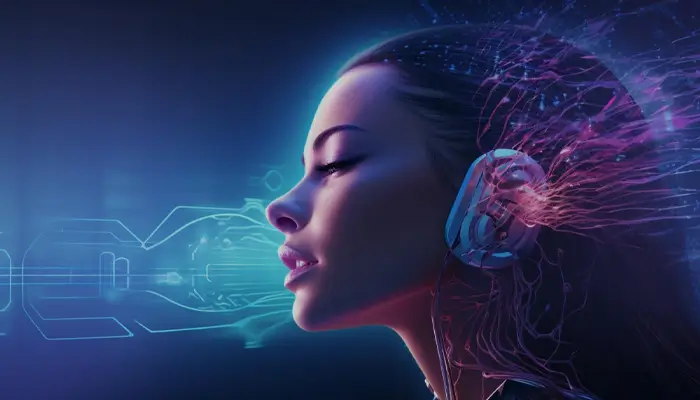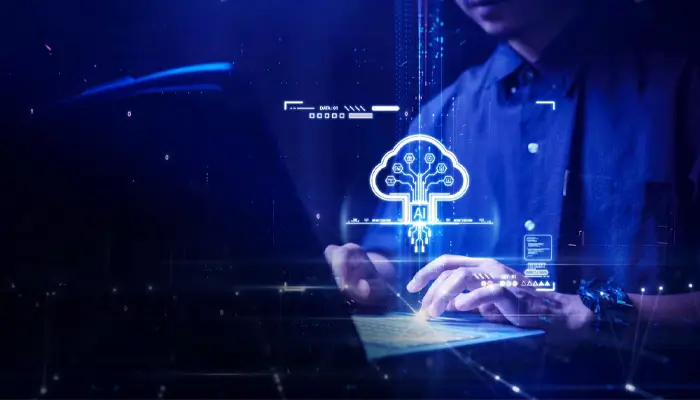
The New Creative Partner: How AI Co-Design Tools Are Redefining Collaboration in 2025
November 7, 2025
The Future of Web Hosting: How AI and Cloud Technology Are Redefining Performance
November 12, 2025Exploring how voice-powered AI tools are reshaping creativity, collaboration and design workflows.
Designing no longer starts with a mouse, it starts with a conversation.
In 2025, voice-driven AI tools like ChatGPT Voice, Adobe’s AI co-pilot and Midjourney’s conversational interface are transforming how creatives brainstorm, edit and design. What once required a series of clicks and commands can now happen through natural speech, faster, smarter and more intuitively.
Voice AI is no longer about giving directions; it’s about creative collaboration. It listens, understands context and executes tasks while adapting to each designer’s personal workflow.
-
The Evolution of Voice AI in Creative Workflows
Voice technology has evolved from simple assistants like Siri or Alexa to intelligent creative partners capable of generating visuals, layouts and even code.
The rise of multi-modal AI systems, tools that process text, image and audio simultaneously, allows designers to:
- Describe design ideas out loud.
- Generate visuals instantly through speech.
- Edit existing designs hands-free.
Example: You can now say,
“Make the logo bigger and change the background to a soft gradient of teal and coral,”
and Adobe’s Firefly or Photoshop AI will execute it instantly, no manual editing required.
This conversational workflow means creatives can focus more on vision and less on execution.

-
ChatGPT Voice: Creative Brainstorming Reimagined
OpenAI’s ChatGPT Voice, launched in 2024, has quickly become a must-have tool for designers and marketers.
By combining speech recognition with generative reasoning, it lets creatives brainstorm, outline and refine ideas in real time.
Use cases include:
- Talking through a campaign concept or mood board.
- Asking AI to “summarize this brand tone in three words.”
- Refining copy tone or slogan ideas hands-free during client meetings.
This fluid interaction allows creative ideation to keep flowing, no typing, toggling or note-taking interruptions.
-
Midjourney’s Conversational Prompts: Talk Your Vision into Reality
The latest version of Midjourney (V7) introduces voice-based visual generation, a leap beyond written prompts.
Designers can now describe visuals naturally:
“Create a futuristic office scene with soft lighting, minimalist furniture and reflective glass walls.”
AI interprets tone, nuance and descriptive phrasing to render precise visuals within seconds.
Why it matters:
For creatives who think visually but struggle with prompt engineering, conversational input lowers the barrier between imagination and output, making ideation more fluid and inclusive.
-
Adobe’s AI Co-Pilot: The Designer’s Conversational Companion
At Adobe MAX 2025, Adobe unveiled its next-generation AI Co-Pilot, a voice-activated assistant embedded across Photoshop, Illustrator, Premiere Pro and XD.
Designers can now:
- Adjust layers or typography via voice.
- Generate new design variations instantly.
- Request “faster rendering,” “lighter shadows,” or “match colours from reference.”
Example:
You can say, “Animate this logo intro to feel more energetic,” and Adobe Co-Pilot will adjust transitions, motion speed and sound cues accordingly, blending creativity with technical precision.
This feature bridges the gap between creative direction and execution, especially useful for multi-tasking designers and content creators.
-
The Accessibility and Inclusivity Impact
Voice-driven design doesn’t just enhance productivity, it expands accessibility.
For designers with mobility challenges, repetitive strain injuries or visual impairments, voice interfaces democratize creativity.
Pro Tip: Adobe and Figma are already integrating voice UX design tools that allow creative professionals to test how users interact with voice commands within their own apps and websites, building a more inclusive digital ecosystem.
-
The Human + AI Synergy: Talking Your Ideas into Existence
In 2025, the best creative workflows combine human intuition and AI execution.
Here’s how that looks:
- You speak your concept → “Design a homepage for a digital marketing agency with modern typography and a clean layout.”
- AI generates a draft layout using Figma AI or Adobe XD Voice Assistant.
- You refine verbally → “Move the CTA higher and add an animation to the hero image.”
- AI executes changes instantly.
Outcome: What used to take hours of manual iteration now happens in minutes, freeing creatives to focus on narrative, emotion and user experience.
-
Ethical and Creative Implications
As AI assistants gain more autonomy, designers must ensure that voice-based creation remains transparent and ethical.
That means:
- Disclosing AI-generated assets in client work.
- Ensuring data privacy in recorded voice interactions.
- Keeping human oversight in creative judgment.
Voice design should empower, not replace, turning AI into a creative enabler, not a decision-maker.
Conclusion
Voice-driven AI is ushering in a new era where creativity feels conversational.
From ideation to execution, tools like ChatGPT Voice, Adobe Co-Pilot and Midjourney’s conversational interface are reshaping how designers think, collaborate and create, faster, more intuitively and more humanly than ever.
In 2025 and beyond, speaking your ideas won’t just inspire creativity, it will create it.
If you have any questions regarding “Voice Driven Design” feel free to contact us. For inquiries and consultations, call us at: +92 321 4808303 or Email us at: hello@owaisgilani.com.
Disclaimer: The information shared on this website is for educational and informational purposes only and reflects my personal views and experiences. While I strive to provide accurate and helpful content, readers should use their own judgment and consult with a qualified professional before making any decisions based on the information here. I am not responsible for any actions taken based on this content. Feel free to reach out to me if you need clarification or have questions before using any part of this information.



